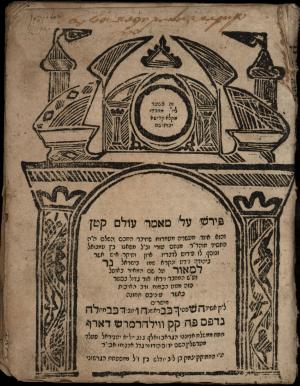Obj. ID: 38928
Jewish printed books Perush al Maamar Olam Katan by Meir ben Chaim, Wilhermsdorf, 1675

This text was prepared by William Gross:
This commentary on Ma'amar Olam Katan is one of the earliest Hebrew books printed in the city of Wilhermsdorf. Its text addresses the configurations of the soul.
Unusual title page with woodcut gateway with broken pediment topped by two waving flags. This frontispiece was used only a few times by the printer.
R. Meir ben Hayyim of Katzenellenbogen (d.c.1700) was among the Jews expelled from Eisenstadt in 1671. He subsequently became a teacher in Prague and afterwards in Stampfen. Katzenellenbogen aspires in his commentary to explain only the literal meaning of this complex work, with is the fourth ma’amar of R. Menachem Azariah de Fano’s ten ma’amarot.
Wilhermsdorg, never a home to a Jewish community of consequence, is noteworthy in Jewish history solely because of the Hebrew printing-houses located there. In 1669 Count Wolfgang Julius granted Isaac Yuedels, scion of the famous Gershoni printing family, permission to open a Hebrew press, the first printing-press in Wilhermsdorf. Yuedels ahd briefly printed in Sulzbach, in 1669, when Wolgang Julius offered him a contract to relocate to Wilhermsdorf. The count, owner of a paper mill, was motivated by the prospect of a Hebrew press as a market for his product. Yuedels was allowed to print whatever he pleased, save that it not include anything against the Christians. He was assisted by workers he brought from Prague, as well as his family, including two younger daughters, Reichel and Rivka, who served as his compositors. The press closed after Yuedel's death in 1690.
sub-set tree:
O | Ornamentation: | Architectural frame
A | Arch
C | Columns | Twisted columns
O | Ornamentation: | Pediment-broken
O | Ornamentation: | Shaped text
|


